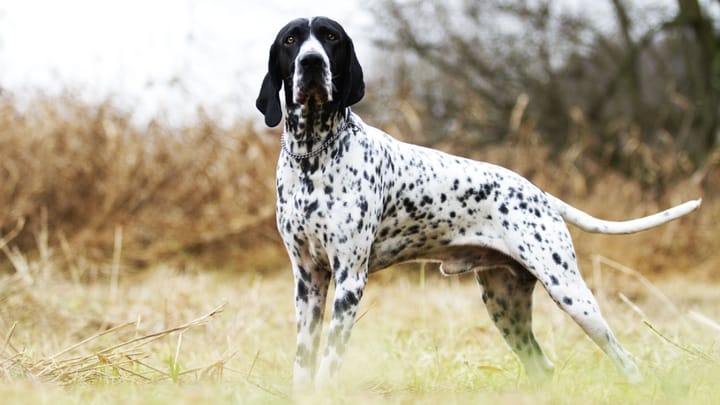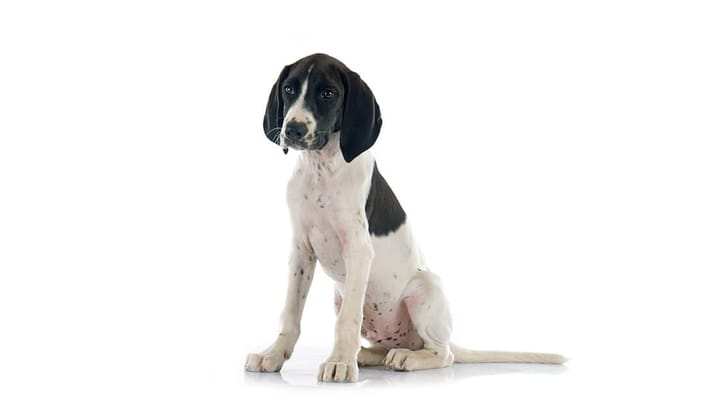Auvergne Pointer
Other names : Braque d'Auvergne, Bleu d'Auvergne


This all-purpose gun dog, the Auvergne Pointer, is also an obedient and sweet-tempered companion dog. Although it’s not massively popular outside of France, it certainly looks very similar to other Pointer breeds. If you are looking for a family dog that is known to be affectionate and gentle too, look no further than the Auvergne Pointer.
|
Life expectancy |
The Auvergne Pointer has a life expectancy of between 11 and 13 years |
|
Temperament |
|
|
Size |
Medium
|
|
Adult size |
Female
Between 22 and 25 in
Male
Between 21 and 23 in
|
|
Adult weight |
Female
Between 49 and 55 lb
Male
Between 49 and 55 lb
|
|
Coat colour
White with black all-over body markings giving a blue tinge. |
Black |
|
Type of coat
This dog has a smooth, short coat, with a glossy appearance. While white with black markings is the only acceptable coat colouring, the markings may be ticked or roan. |
Short |
|
Eye colour
Dark hazel. |
Brown
|
|
Purchase price |
The Auvergne Pointer costs between £1200 and £1500 |
Although often used and bred as a working and pointing dog, the Braque d'Auvergne does not like working independently, much preferring to instinctively understand his master’s requirements and to respond effectively. Because of this, together with his eagerness to learn, he is the ideal candidate for working trials and agility tests.
More details about the Auvergne Pointer
Auvergne Pointer: Origins and history
Although the exact heritage of the Braque d'Auvergne breed isn’t documented, it is certainly an old breed developed during the 1700s in France. During the 1600s, the Braque Francais breed was very popular and it is understood that this breed was crossed with other scenting and working dogs in the Braque region. The Auvergne Pointer breed was recognised by the UK Kennel Club in 2006.
Physical characteristics of the Auvergne Pointer
The Auvergne Pointer dog has a noble appearance, with a large, rectangular body contour. The dog’s facial shape where the skull and muzzle are not parallel gives the dog a Roman-type nose. The dog’s ears hang down and have rounded edges. The dog has a muscular body, while he carries his tail quite high and horizontal. His strong legs will carry him over long distances and many terrains.
FCI classification of the Auvergne Pointer
-
Group 7 - Pointing Dogs
-
Section 1 : Continental Pointing Dogs
Auvergne Pointer: Characteristics
Auvergne Pointer: Behaviour
Training a Auvergne Pointer
As a very intelligent canine, the Braque d'Auvergne learns quickly and responds to training routines. Hunting routines come naturally to him and rarely need to be taught. However, this dog needs to be active so bear this in mind and keep him engaged with varied activities and tasks.
Auvergne Pointer: Lifestyle
Breed compatibility Auvergne Pointer
Auvergne Pointer: Purchase price
As a rare breed, you can expect to pay between £1200 to £1500 for a Braque d'Auvergne puppy. Considering his large size, monthly costs to feed and maintain him will be between £100 to £120.
Auvergne Pointer: Shedding
Average
The Braque d'Auvergne sheds hair moderately.
Auvergne Pointer: Grooming
With his short coat, grooming isn’t too much of a challenge. Of course, brushing the dog’s coat several times weekly will help to prevent shedding. As a dog who is hunting in the fields and woods, be prepared to check his ears for debris and grime to prevent any ear infections and problems.
Auvergne Pointer: Health
Although a healthy breed generally, the Braque d'Auvergne may suffer occasionally from congenital health issues. It's life expectancy is 11 to 13 years.
Certainly a strong and enduring dog who is capable of working in the field for most of the day when required to.
As a short-haired breed, the Auvergne Pointer doesn’t have any problems during periods of hot weather or when enduring runs over long distances.
As a canine that is used to hunting and working in the mountainous regions of France, this dog doesn’t generally experience problems working outdoors in all weathers. However, he is also just as happy to remain at home, in the comfort of a heated house.
A very active and energetic dog, who will burn many calories when working. On the other hand though, a dog who is more of a companion pet will be prone to obesity if overfed and not given sufficient exercise.
- Canine hip and elbow dysplasia
- Patellar luxation
- Eye problems
- Demodex mange
- Cleft lip
- Aortic stenosis






